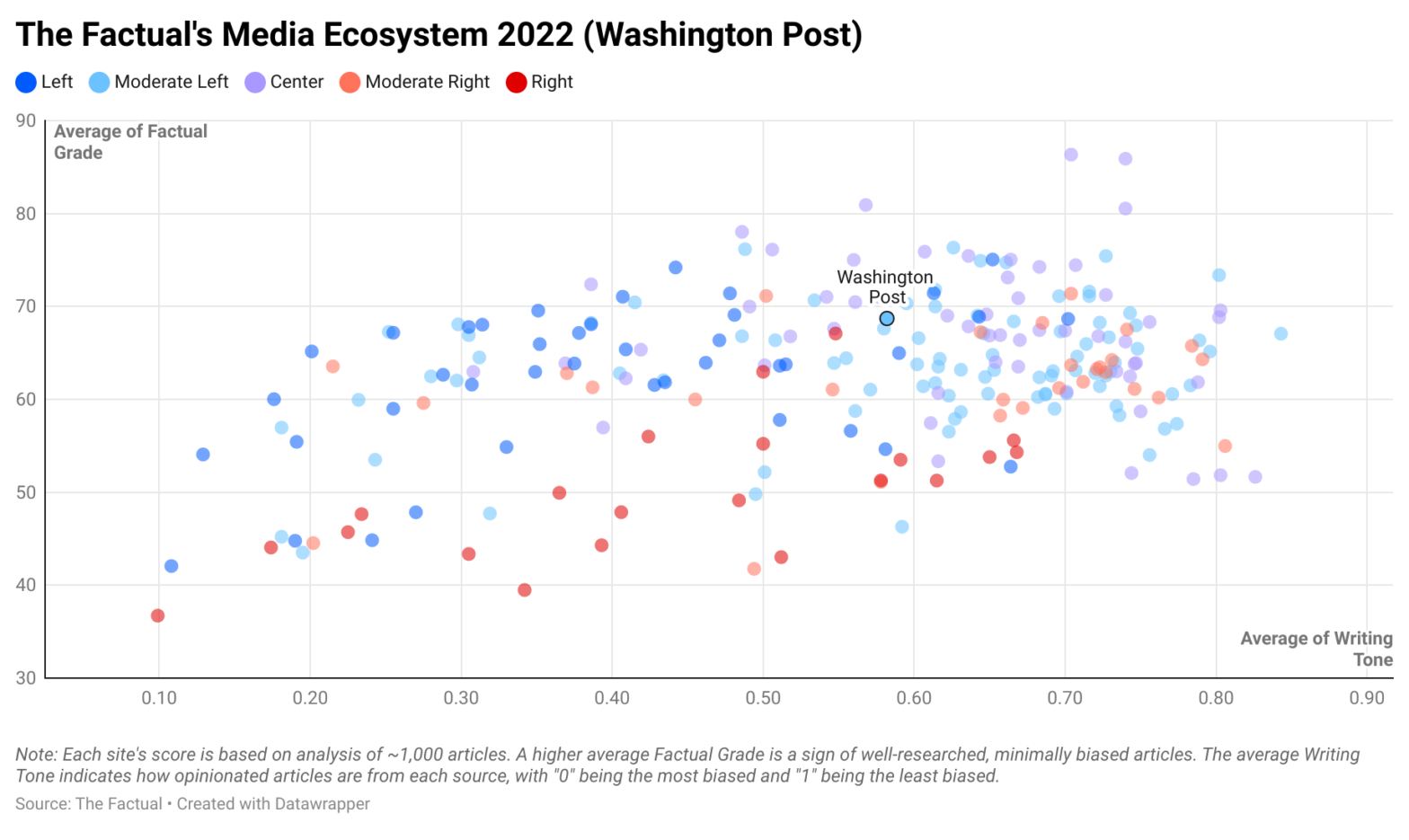The Washington Post enjoys a reputation for being one of the nation’s most prominent newspapers. However, its reporting at times receives criticism for left-leaning bias and complications related to its ownership by Amazon’s Jeff Bezos. This makes it worth asking two important questions: how reliable is the Washington Post and how biased is its coverage?
How Does The Factual Rate News Sources?
The Factual analyzes more than 10,000 news stories every day to help readers find the most informative, least-biased articles. Our news-rating algorithm scores each article along four metrics: (1) cited sources and quotes, (2) publication history, (3) writing tone, and (4) author expertise. These scores combine in a weighted average we call a Factual Grade, which ranges from 0–100%. (See our How It Works page to learn more about our algorithm.)
For this study, we analyzed ~1,000 articles each from 240 news sources. The average Factual Grade for the entire dataset was 62.5%. Based on these averages, we can compare the performance of news sites across the media ecosystem. The entire dataset can be explored in greater detail here.
How Factual Is the Washington Post?
The Washington Post scored an average Factual Grade of 68.7%, placing the publication in the 79th percentile of our dataset. These moderately high scores can be attributed to several factors. For example, articles commonly include ample links to external sources and direct quotes to support their reporting. Likewise, the Washington Post employs dedicated reporters who routinely publish high-quality articles on the same subjects. However, scores are dragged downwards by opinionated language (see below).
Like any news source, scores for articles from the Washington Post varied widely based on factors like author expertise and cited evidence. For example, some scored above 80%, while others scored below 50%.
Please check your email for instructions to ensure that the newsletter arrives in your inbox tomorrow.
How Opinionated Is the Washington Post?
The Factual also measures how opinionated an article is using a sophisticated natural language processing algorithm, producing a score we call the Writing Tone. For this metric, the algorithm looks for signs of subjective commentary (e.g., first person pronouns, unnecessary adverbs), as well as the emotional nature of selected words, and sees how prevalent they are for a given length of text. Text which is less opinionated gets higher ratings, with “0” being the most opinionated and “1” being the most neutral.
The Washington Post had an average Writing Tone score of 0.58, placing it in the 44th percentile in our dataset for this metric. This suggests that many articles from the site exhibit opinionated writing. This can be seen in headlines such as “Trump again summons the mob” and “Facebook misinformation is bad enough. The metaverse will be worse.”
How Biased Is the Washington Post?
The Factual classifies news sites by political bias as either Left, Moderate Left, Center, Moderate Right, or Right. This classification comes from third-party assessments from media bias organizations such as AllSides and Media Bias/Fact Check (MBFC). Based on this data, The Factual assigns the Washington Post a Moderate Left bias.
AllSides gives the Washington Post a “Lean Left” bias, based on survey data, editorial review, and over 60,141 community ratings. The most recent analysis from AllSides comes from a survey of 1,414 people across the political spectrum placed the newspaper on the border between “Lean Left” and “Center.” This survey revealed that surprising portions of left-leaning readers saw the newspaper as slightly conservative, while a majority of right-leaning readers saw it as slightly liberal.
Media Bias/Fact Check (MBFC) reaches a similar conclusion, giving the Washington Post a “Left-Center” classification. The publication “often publishes factual information that utilizes loaded words to favor liberal causes,” according to MBFC. They also give it credit for “Mostly Factual” reporting and use of credible sources. MBFC documents two failed fact checks, one related to Russian hacking and another related to the 2020 presidential election.
Other aspects of the newspaper’s operation make an overall left-leaning bias apparent. For example, it has endorsed Democratic presidential candidates in every election since 1976. Likewise, article titles, particularly in the opinion section, reveal some bias: “The Trump administration created this awful border policy. It doesn’t need Congress to fix it.” and “Biden is making the Trump presidency seem like a golden age of unity.”
Who Owns the Washington Post?
Amazon founder and executive chairman Jeff Bezos famously owns the Washington Post. Executive Editor Martin Baron has insisted that Bezos has not tried to influence the output of the paper: “He’s never suggested a story to anybody here, he’s never critiqued a story, he’s never suppressed a story.” The paper argues this is still the case in 2021.
There are instances of articles that clearly favor Bezos and Amazon, such as “Think twice before changing the tax rules to soak billionaires.” However, they also published articles that are highly critical of Amazon, such as “Amazon Key is Silicon Valley at its most out-of-touch.”
Please check your email for instructions to ensure that the newsletter arrives in your inbox tomorrow.
How to Mitigate Bias
News articles are bound to have bias because all authors have some frame of reference within which they describe a story. Political bias ratings are helpful in understanding this framing. However, it can be more beneficial to know how factual an article is based on quantifiable metrics that can be seen across the media ecosystem, such as cited evidence, author expertise, and writing tone. This is what The Factual ascertains.
Reading several, highly rated articles from across the political spectrum helps counter the bias of any news source or story. To have the day’s most factual news stories delivered to your inbox every morning, subscribe to our daily newsletter.
Article updated on September 22, 2022 to reflect new data.

